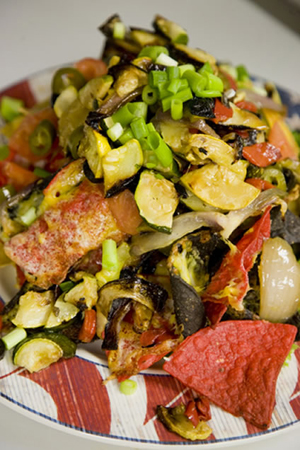
Ingredients
1 pound medium-small waxy potatoes such as Red Bliss, unpeeled
8 ounces young green beans
1 cup fresh shelled peas (optional)
2 medium carrots
1/2 small cauliflower
2 or 3 ounces guajillo* chiles (about 14-20 chiles)
1 ounce Amarillo* chiles (about 10 small chiles)
1-inch piece canela* (cinnamon)
10 garlic cloves, coarsely chopped
1 teaspoon dried thyme, crumbled
6 teaspoons cider vinegar
1 1/2 to 2 teaspoons salt, or to taste
8 ounces queso fresco*, crumbled, or 4 ounces queso añejo*, grated; or substitute equal amounts of crumbled young or grated aged ricotta
1 medium onion, cut into paper-thin half-moons
1 1/2 teaspoons dried Mexican oregano*, crumbled
Directions
First prepare the vegetables: Have ready a large bowl of ice water, with more ice in reserve. Bring a large pot of salted water to a boil. Add the potatoes and cook until barely tender, about 15 minutes (depending on their size). Lift out, drain, peel, and cut into 1/2-inch dice. Remove the strings from the green beans if necessary. Cut into short pieces (about 1/4 inch) and cook with the peas until barely tender, about 5 to 7 minutes. Scoop out the beans and peas with a strainer or slotted spoon and at once plunge them into the ice water to stop the cooking. Scoop out and drain. Peel the carrots, cut into 1/4-inch dice, and cook until barely tender, about 3 to 5 minutes, chilling and draining in the same way. Separate the cauliflower into small florets; cook until barely tender, about 4 to 6 minutes, chilling and draining in the same way. Set the vegetables aside.
Remove and discard the tops and seeds from the guajillo chiles. Rinse the guajillos under cold running water and shake off excess moisture, but do not dry them. Heat a griddle or cast-iron skillet over medium-high heat until a drop of water sizzles on contact. Place a few guajillos on the griddle and heat, turning occasionally with tongs, just until any clinging moisture is evaporated and the aroma is released, about 25 seconds. (The chiles should just become dry, hot, and fragrant; do not allow them to start really roasting or they will have a terrible scorched flavor.) Remove from the griddle as they are done, and repeat with the remaining guajillos.
Place the guajillo and amarillo chiles in a deep bowl, cover generously with boiling water, and let soak for 20 minutes. Meanwhile, grind the canela in an electric coffee or spice grinder.
Drain the chiles and place in a blender with the ground canela, garlic, thyme, vinegar and enough water to facilitate blending (about 1 cup). Process on high for about 3 minutes, until you have a smooth purée. With a wooden spoon or pusher, force the purée through a medium-mesh sieve into a bowl.
In a large non-reactive bowl (glass, stainless steel or plastic), toss the cooked vegetables with the puréed chile mixture and salt. Cover with plastic wrap and refrigerate for at least 4 hours, preferably longer. It will be better if left overnight — or even better after two days.
When ready to serve, combine the cheese, sliced onion, and oregano in a small bowl and toss to distribute evenly. Heap the marinated vegetables on a serving platter, topping with the cheese-onion mixture. Serve with fresh corn tortillas or fried tortilla chips.
*Tips:
Guajillos are large, dark-red, dried chiles with a nutty flavor and not too much heat.
Amarillos are a small, hot, yellow-red variety with a citrusy flavor.
Canela, also called True, Mexican, Ceylon, or Sri Lanka cinnamon, is a less pungent variety than the cassia cinnamon commonly used in the U.S.
Queso Fresco is a young, crumbly, mild cow’s milk cheese.
Queso Añejo is the Mexican name for any aged cheese, the most common of which is cotija, a hard, salty variety. Both are available by mail order from the Specialty Cheese Company at www.specialcheese.com Mexican oregano has a more assertive flavor than the Mediterranean oregano common in the U.S. Mexican oregano is sold in Latin American groceries and in many supermarkets under the McCormick brand.
Country:
Mexico
Notes and Instructions
In Mexico, chiles are traditionally dry-roasted on clay implements called comals, which impart the perfect seared flavor. A large, heavy griddle or skillet, ideally cast iron, makes a good substitute. Avoid nonstick skillets as the coatings may peel over high heat.
